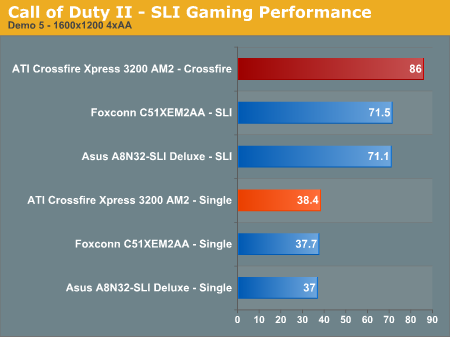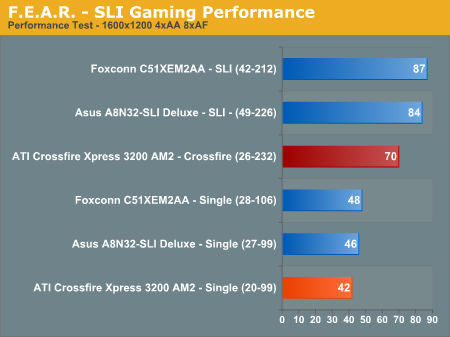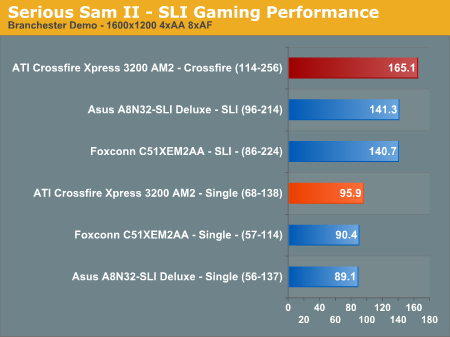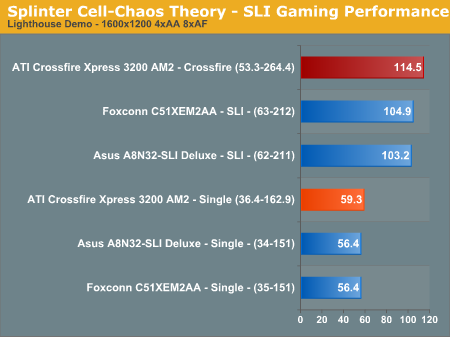CrossFire Xpress 3200: RD580 for AM2
by Wesley Fink on June 1, 2006 12:05 AM EST- Posted in
- Motherboards
CrossFire Gaming Performance
Both major players in the Video Market now have flagship Dual X16 solutions. SLI and CrossFire are about gaming, so CrossFire tests were confined to gaming benchmarks, and the test suite is heavily slanted to recent and popular titles where SLI and CrossFire make the biggest difference. All CrossFire testing was at 1600x1200, 4X AA, and 8X AF. Tests were also run with a single X1900 XT at this same resolution. The single video high-res results on the ATI AM2 are in Orange and the CrossFire results are in Red.





You might think you are looking at results from different video cards in CrossFire/SLI performance. Here leads are larger and positions are often switched from results at standard resolution without the eye candy. ATI CrossFire is the clear winner in Serous Sam 2, COD2, and Splinter Cell: Chaos Theory, while NVIDIA SLI owns Half Life 2 and F.E.A.R. We suspect part of these multi-GPU results revolve around which card has the best optimized drivers available.
We complained about ATI's CrossFire interface in our last two CrossFire reviews, and it still remains clumsy and anything but intuitive. To use CrossFire you MUST install Catalyst Control Center. If CCC is not installed CrossFire will not work. Since many users don't install CCC this is anything but an intuitive solution for CrossFire. Once installed, you must go into CCC, select the CrossFire tab and enable the feature. This is a MANUAL procedure - there is no warning at all that you have a CrossFire capable board or that you have to go into CCC to enable CrossFire. NVIDIA warns you that an SLI-capable system is installed and prompts you to enable SLI. There is no warning at all with ATI. The only clue you will have that CrossFire is NOT turned in is the poor performance results. THEN you start looking for what's wrong. ATI really needs to fix this issue. CrossFire performance is very good, but it would be much nicer if ATI made it easier to turn on CrossFire.
Both major players in the Video Market now have flagship Dual X16 solutions. SLI and CrossFire are about gaming, so CrossFire tests were confined to gaming benchmarks, and the test suite is heavily slanted to recent and popular titles where SLI and CrossFire make the biggest difference. All CrossFire testing was at 1600x1200, 4X AA, and 8X AF. Tests were also run with a single X1900 XT at this same resolution. The single video high-res results on the ATI AM2 are in Orange and the CrossFire results are in Red.





You might think you are looking at results from different video cards in CrossFire/SLI performance. Here leads are larger and positions are often switched from results at standard resolution without the eye candy. ATI CrossFire is the clear winner in Serous Sam 2, COD2, and Splinter Cell: Chaos Theory, while NVIDIA SLI owns Half Life 2 and F.E.A.R. We suspect part of these multi-GPU results revolve around which card has the best optimized drivers available.
We complained about ATI's CrossFire interface in our last two CrossFire reviews, and it still remains clumsy and anything but intuitive. To use CrossFire you MUST install Catalyst Control Center. If CCC is not installed CrossFire will not work. Since many users don't install CCC this is anything but an intuitive solution for CrossFire. Once installed, you must go into CCC, select the CrossFire tab and enable the feature. This is a MANUAL procedure - there is no warning at all that you have a CrossFire capable board or that you have to go into CCC to enable CrossFire. NVIDIA warns you that an SLI-capable system is installed and prompts you to enable SLI. There is no warning at all with ATI. The only clue you will have that CrossFire is NOT turned in is the poor performance results. THEN you start looking for what's wrong. ATI really needs to fix this issue. CrossFire performance is very good, but it would be much nicer if ATI made it easier to turn on CrossFire.










71 Comments
View All Comments
lopri - Thursday, June 1, 2006 - link
Most of responses below my post didn't read my points. I'll be paitently waiting for AT staff's responses. In the meantime, you guys can check:http://www.anandtech.com/memory/showdoc.aspx?i=267...">http://www.anandtech.com/memory/showdoc.aspx?i=267...
http://www.anandtech.com/memory/showdoc.aspx?i=239...">http://www.anandtech.com/memory/showdoc.aspx?i=239...
And the sub-reviews. If DDR400(2-2-2) are DDR600(2.5-3-3), I guess all those memory reviews on AT were wasting of time?
Ahe here is the DIMM sticks this review used for AM2 platform.
http://www.newegg.com/Product/Product.asp?Item=N82...">http://www.newegg.com/Product/Product.asp?Item=N82...
Oh that's not it. While searching, I found that decent DDR2-800 would cost >$250, and higher speed/same timing or same speed/timing sticks will (if you were to buy) dig a big hole in your packet. (think $500) Is that mainstream? What about the 1T issue??
The top of the line Socket 939 vs Socket AM2 comparison could be something like this:
2 x 512MB: DDR600 with 2.5-3-3-7 (less thanl $150) vs DDR2-800 with 3-3-3 ($500) or,
2 x 1GB: DDR500 with 2.5-3-2-7 (less than $200) vs DDR200-800 with 4-4-4 ($250)
Think about how mwny mobo/memory reviews we've seen here on AT? Why don't we use the knowledge we learned from those founding to compare Socket 939 and Socket AM2?
Spoelie - Thursday, June 1, 2006 - link
You need a reality check. Lots of reviews have pointed out that the higher cost of TCCD memory and such is not worth the little extra performance, except if you're a serious overclocker that just really wants to run his mem on 1:1 and need the frequency headroom.The common setup out there is not 270-2.5/3/2 or whatever, it is 200-2.5/3/3/8 or even CL3. Especially with the higher density memories like 1GB sticks. THAT is what most persons are running. If anything, the 2/2/2 200 are a bit too high end for the majority of people. And they're also reading AT.
lopri - Thursday, June 1, 2006 - link
What you're saying is not totally out of my context. My main meat was towards the reviewers. Does anyone here own a DDR2-800/3-3-3? (Forget about TCCD 270MHz) DO you know how much they are? Indeed, such memory is not even officially out yet. But AT is using those sticks for AM2 system but at the same time for Socket 939 system they use more "pedestrian" DDR400/2-2-2. These days you can by 2 x 1GB DDR400/2-3-2 for under $200.Wesley Fink - Thursday, June 1, 2006 - link
The Corsair 8500 we used for testing is NOT rated at DDR2-800 3-3-3 - it is actually rated at DDR2-1066 5-5-5-15. The fact is it will run at DDR2-800 3-3-3 with voltage in the 2.1 to 2.2v range. So will most other recent dimms based on Micron memory chips. At stock voltage of 1.8v it runs about 4-4-4-13.Where TCCD was capable of DDR400 2-2-2 and DDR500 2.5-2-3 or 2.5-3-3, Micron chips are currently the top-performing chips for DDR2. Infineon also has DDR2 chips that perform at lower latency and they are generally priced more reasonably.
Our memory articles ALWAYS compare performance at different memory speeds, but the fact is DDR400 was the fastest memory standard for DDR. Anything higher was overclocking. For DDR2, we have DDR2-800 as the current highest standard speed, though there will likely be a DDR2-1066 speed in the near future.
When we point out that the massive bandwidth increases in DDR2 on AM2 have almost no impact on performance, surely it is obvious that AM2 is not memory bandwidth starved. We found on DDR that the on-chip memory controller for AMD was very sensitive to latency improvements. In fact hte mad shrimp article unintentionally shows just that - gaming responded more to latency improvement than bandwidth improvement. That will also likely be the case in DDR2 EXCEPT with such a massive increase in bandwidth over DDR, latency may not matter nearly so much. We will take a closer look at htis in a future memory article.
peternelson - Thursday, June 1, 2006 - link
Price of fast, low latency DDR2 will come down once AMD users start buying it in volume. That will come, so it is not unrealistic to benchmark now using fast expensive highend memory, because it won't be as expensive or uncommon in a month or two or three when boards are in most stores and consumers are buying them in bulk eg for "back to school/college" or "Christmas holidays season" which are when sales peak. Conroe should also improve the market availability for high performance DDR2 memory.
On the other hand there are reports of far east short-term wholesale prices of ddr2 generally having a rise because of more demand.
Spoelie - Thursday, June 1, 2006 - link
http://www.madshrimps.be/?action=getarticle&ar...">http://www.madshrimps.be/?action=getarticle&ar...peternelson - Thursday, June 1, 2006 - link
AMD are moving to AM2 with or without you.
Get over it.
You will not be able to get AMD's top performing new models if you stay with 939. Ditto the 65nm processors will also be on AM2.
939 WILL be phased out sooner or later, and with it goes DDR support.
Therefore it is somewhat irrelevant question to complain about the speed of the DDR. There won't BE any DDR support going forwards. Make the transition.
lopri - Thursday, June 1, 2006 - link
Did you even read my post? What was I saying?It has nothing to do with AM2 transition and I have nothing against AM2.
peternelson - Thursday, June 1, 2006 - link
Yes, the ddr comments relate to your Q1 section, not the DDR2 discussion.
Sorry if my response seemed overly critical.
lopri - Thursday, June 1, 2006 - link
On page 3, in the tablePCIe Speeds | 100 to 2000 in 1MHz Increments